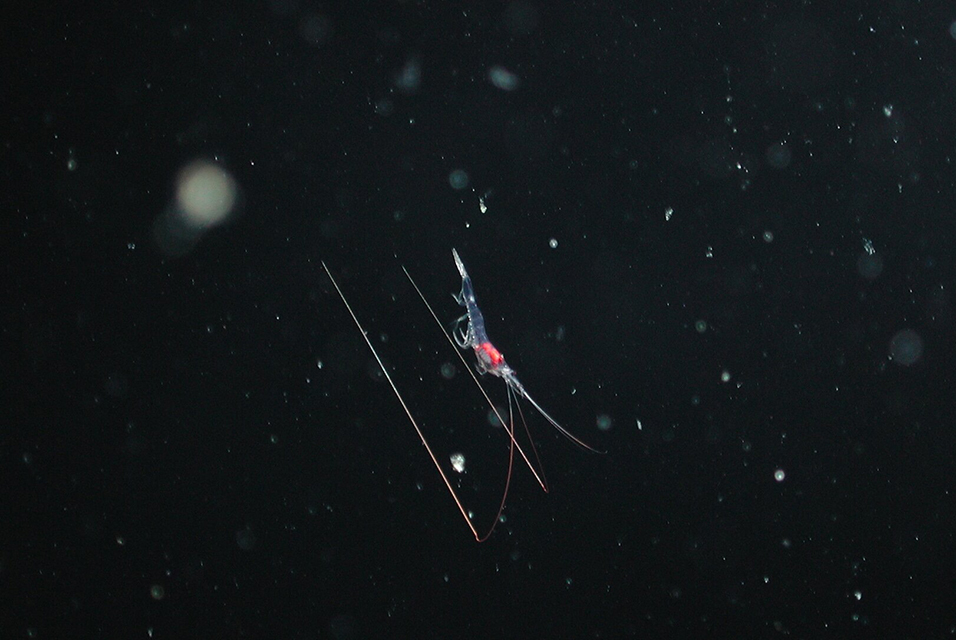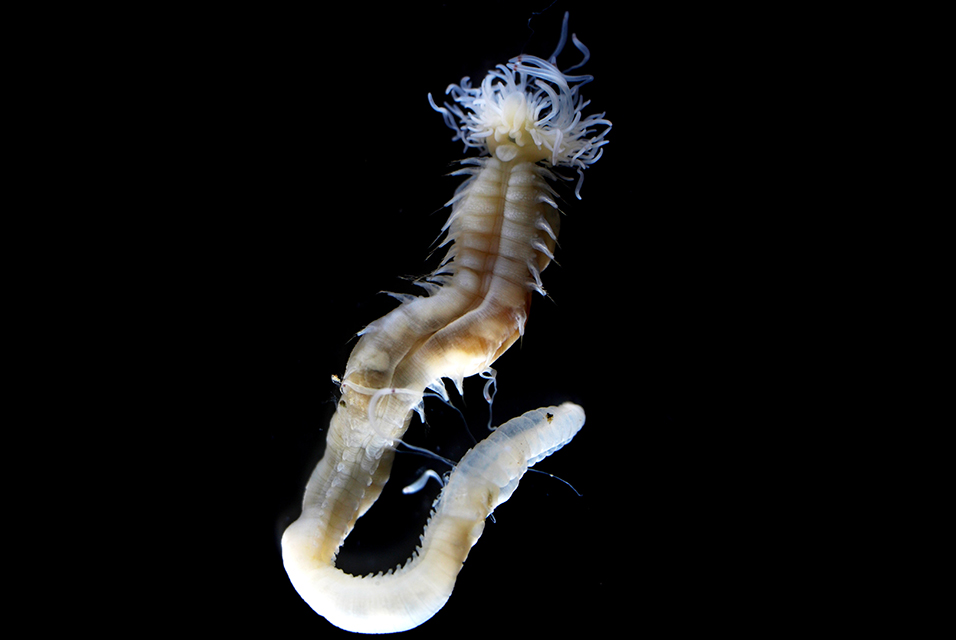MOSS LANDING, CA.- For California's Central Coast, wind is much more than weather.
Spring and summer bring offshore, northwesterly winds to Central California. Those winds push the top layer of water out to sea, then colder, deeper water rises from below to replace it. This process is known as coastal upwelling and it contributes to the bounty of life in Monterey Bay.
The influx of cool, nutrient-rich water fuels blooms of tiny plankton and kickstarts the bay's food web. Tiny plant-like phytoplankton feed swarms of krill and zooplankton. Those tiny animals feed bigger and bigger animals, including salmon, tunas, and even blue whales.
Researchers have long recognized how the ocean responds to seasonal changes in wind and weather. However, specific details of these interactions—especially the biological impact of upwelling in the full ocean water column—have not always been clear.
A new study published in the Proceedings of the National Academy of Sciences uses data from
MBARI's long-term monitoring of ocean ecosystems to fill in the gaps in our understanding of upwelling.
"Off California, winds drive seasonal upwelling that support ocean productivity. But the specific links between physics (how strong the wind is) and biology (how many animals there are) aren't always apparent. We don't see the connection very easily because winds are variable and there's a lot of noise. This study uses data from MBARI's long-term monitoring of the ocean to help solve the puzzle. We're revealing the connections between physics and biology," said Monique Messié, a senior research specialist at MBARI and lead author on the study.
Coastal upwelling is a fundamental process in marine ecology. The boom of productivity in the ocean's surface waters is believed to cascade throughout the water column, with variations in coastal upwelling driving changes in marine ecosystems from the surface to the seafloor.
However, this paradigm has yet to be formally tested and examined in detail due to the lack of long-term biological time series—extended monitoring of marine communities, detailing the ebb and flow of organisms—across the ocean's full water column. The few existing time series usually focus on life in the ocean's sunlit surface waters.
Messié leads MBARI's Data Integration and Interdisciplinary Oceanography Team and collaborates with various research teams to integrate data from different disciplines, instruments, and regions to study ecosystem processes and physical-biological interactions in the coastal and open ocean.
MBARI has unique long-term monitoring data for the ocean's surface, the midwater, and the deep seafloor that can bring a unique perspective to our understanding of upwelling. The Data Integration and Interdisciplinary Oceanography Team sought to integrate the datasets from three different research teams to better understand connections between the atmosphere and the ocean.
Since 1989, MBARI's Biological Oceanography Group—led by MBARI Senior Scientist Francisco Chavez—has been monitoring plankton populations in the surface waters of Monterey Bay. Every few weeks, researchers have collected water samples at MBARI's M1 station, located in the middle of Monterey Bay, as part of the Monterey Bay Time Series. These samples are analyzed under a microscope, and plankton species are meticulously identified, sized, and counted to estimate the biomass of plankton groups such as diatoms, dinoflagellates, ciliates, and picoplankton.
For more than 25 years, MBARI Senior Scientist Bruce Robison and MBARI's midwater ecology team have been surveying the midwater of Monterey Bay—the vast expanse of open water deep below the bay's surface and far above the floor of the Monterey Canyon. Using MBARI's remotely operated vehicle (ROV) Ventana, the midwater ecology team conducts monthly quantitative video transects of the local midwater fauna. This video is expertly annotated by research technicians in MBARI's Video Lab, allowing researchers to see patterns in animal populations over time.
And for more than three decades, former MBARI Senior Scientist Ken Smith monitored the abyssal seafloor off Central California as part of the Station M Long-term Time Series. Station M is located at the furthest reaches of the Monterey Canyon, where the Monterey Fan joins the abyssal plain around 4,000 meters (13,100 feet) deep, approximately 220 kilometers (137 miles) west of Santa Barbara, California. MBARI has deployed a suite of technologies at Station M, including ROVs that conducted visual surveys of life on the deep seafloor.
Due to their decades-long duration and focus on different habitats, these time series offer an unprecedented opportunity to investigate ecosystem variability over a range of temporal scales across the full water column and deep seafloor. Messié was curious, does variation in upwelling indeed drive ecosystem temporal variability from the surface to the deep seafloor? If so, what are the processes by which this forcing occurs?
Researchers at the Georgia Institute of Technology and Scripps Institution of Oceanography had previously used long-term time series data to explore how ocean ecosystems respond to changes in the atmosphere, but this previous work focused on surface ecosystems. Messié applied similar data analysis to all three MBARI time series to reveal patterns from the surface to the abyssal seafloor.
Combining these datasets revealed how biological communities throughout the water column respond to atmospheric forcing. Changes in the atmosphere, like seasonal winds and upwelling, have a signal that persists throughout surface, midwater, and seafloor habitats.
"It's amazing how one process has so many diverse effects on life in the ocean. Its expression can be very different depending on the marine community itself. To disentangle the connection between physics and biology, we had to take into account these biological processes that 'transform' the original physical forcing," said Messié.
Analyzing the three datasets together revealed how biological processes, like animal interactions and lifespans, transform the power of the wind and atmosphere. Understanding the links between the three time series was challenging because they displayed such different temporal variability from each other.
Within each time series, the community increases and decreases in density and biomass over time. But this ebb and flow of life is not the same from time series to time series. The surface community varies considerably with seasonal blooms of short-lived plankton. However, the midwater and abyssal seafloor communities experience more variation on longer time scales, such as from year to year.
"Upwelling brings a flood of nutrients, and marine life responds quickly to the bounty of food. That impact on the biological community lasts for a long time, sometimes for years," said Messié.
At the ocean's surface, the biological response to coastal upwelling persisted for about two weeks. On the abyssal seafloor, the response persisted more than three years after the initial upwelling event. The signal persistence was not as clearly defined in the midwater community, but was at least a year.
These results suggest that coastal upwelling influences ecosystems from the surface ocean through the water column to the deep seafloor. The connection most likely occurs directly via changes in photosynthetic phytoplankton (primary production), the sinking of organic matter to the seafloor (vertical export), animal feeding interactions, and to a lesser extent indirectly via other oceanic changes.
The timescales over which species respond to upwelling—the period of time over which marine life responds to the upwelling signal—are taxon-specific and are likely related to organism longevity. Identifying the time over which the upwelling signal persists for given species can provide information about how long animals live, which is still very difficult to measure, especially in deep-sea animals.
"MBARI's three long-term time series are packed with data, including some surprising findings. Our work provides clues to lifespan estimates for marine animals, which is still a highly hypothetical result, but potentially very important since longevity is so hard to estimate," said Messié.
This research underscores the unexpected discoveries MBARI researchers have made in our unique long-term monitoring of California's Central Coast.










